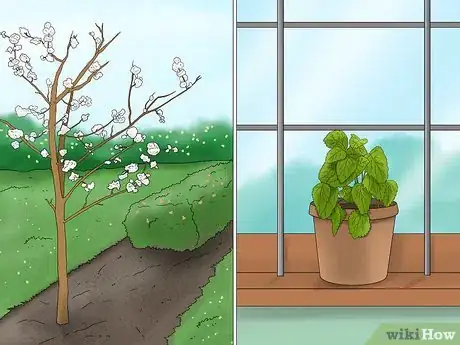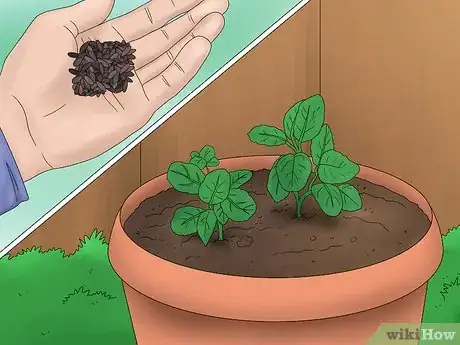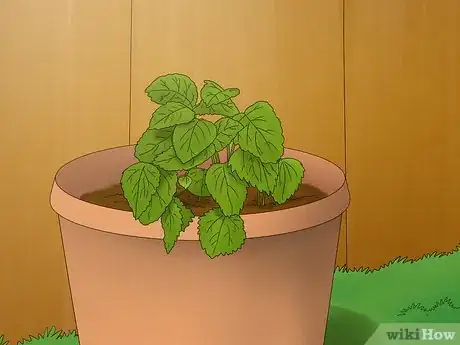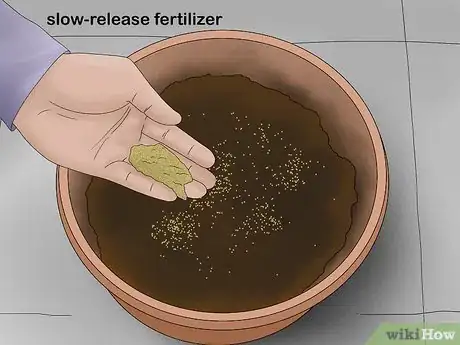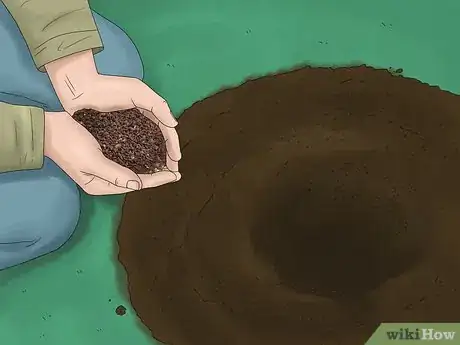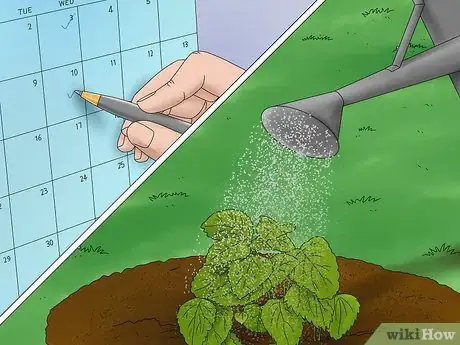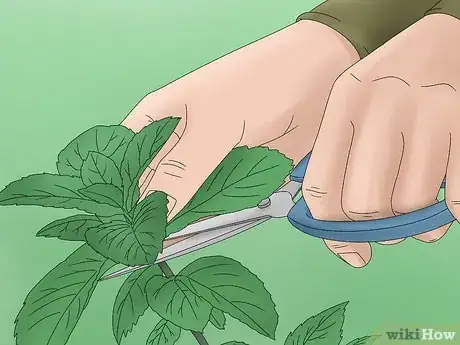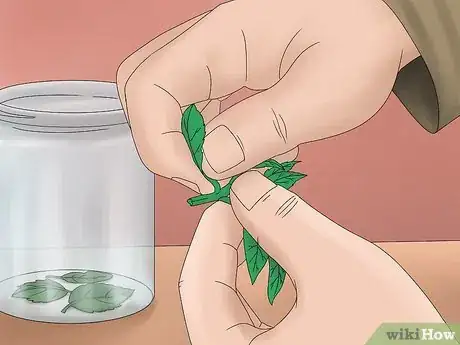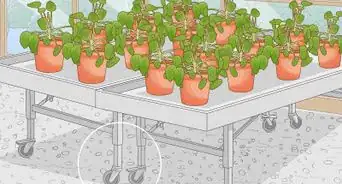This article was co-authored by Lauren Kurtz. Lauren Kurtz is a Naturalist and Horticultural Specialist. Lauren has worked for Aurora, Colorado managing the Water-Wise Garden at Aurora Municipal Center for the Water Conservation Department. She earned a BA in Environmental and Sustainability Studies from Western Michigan University in 2014.
This article has been viewed 25,369 times.
Lemon balm, also known as common balm or mint balm, is a calming herb that belongs to the mint family. As its name implies, it has a lemony flavor that makes it ideal to use for tea, salads, herbal infusions, and other dishes. But while you can find dried lemon balm at many herb shops, the fresh variety isn't as readily available. The good news is that lemon balm is pretty easy to grow so you can plant your own and have a steady supply whenever you need it. All it requires is a sunny spot, moist soil, and a little fertilizer for healthy growth.
Steps
Selecting the Time and Place to Plant
-
1Choose the right time to plant. Lemon grows best in cooler weather, so it’s best planted in the spring after the last frost. However, you can also plant it in later summer when the weather starts to cool.[1]
- You can also grow lemon balm indoors. Choose a large pot that’s at least 6 to 8 inches (15 to 20 cm) deep and wide, and keep it in a location where it will receive significant sun during the day.
-
2Purchase lemon balm seeds or seedlings. You can plant lemon balm from seeds or seedlings, which are young plants that have already sprouted stems. In most cases, you’ll have easier time using seedlings, though lemon balm seeds are fairly hardy and usually sprout without much trouble.[2]
- It typically takes 6 weeks for lemon balm seeds to develop into seedlings.
- If you or a friend has an existing lemon balm plant, you can harvest a shoot from the plant and place it in a glass of water. Change the water daily, and once the shoot begins to root, you can plant it outdoors or in a container.
Advertisement -
3Select a planting spot that receives plenty of sun. Lemon balm grows best in a location that receives full sun. However, it is partially shade-tolerant, so it can do well in a spot that receives some shade in the afternoon.[3]
- Even if you plan to grow the lemon balm outdoors, you may want to plant it in a container. That way, you can easily move it around your yard or deck to find the ideal spot.
Planting the Lemon Balm
-
1Use a rich, well-drained soil for planting. When it comes to choosing soil to grow the lemon balm in, opt for a rich, well-drained clay or sandy loam. Ideally, you want the soil to have a pH between 6.0 and 7.5.[4]
- Soilless potting mixes, vermiculite, perlite, coco peat, and rockwool are also ideal mediums for growing lemon balm as long as you fertilize them regularly.
-
2Add slow-release fertilizer to the soil. Lemon balm doesn’t require a lot of fertilizer for healthy growth. However, it’s still a good idea to mix in some slow-release fertilizer into the soil when you plant to ensure that the plants receive a steady supply of nutrients over time.[5]
- A slow-release fertilizer with a 19-19-19 ratio of nitrogen, phosphorus, and potassium is ideal for growing lemon balm.
- Be sure to read the fertilizer label to determine the proper amount to add to your lemon balm plants and how often you need to reapply it.
-
3Space the lemon balm evenly in the soil. When it comes time to place the lemon balm in the soil, proper spacing is key because it can spread quickly as it grows. Place seeds 1⁄4 inch (0.64 cm) beneath the soil and seedlings at the same depth that they are in their containers, and space the plants so they’re at least 12 to 15 inches (30 to 38 cm) apart.[6]
- You may need to thin the seedlings as they grow so there is enough space between the plants.
Caring for Lemon Balm
-
1Water the lemon balm weekly. Lemon balm requires soil that is consistently moist for healthy growth. It’s best to water it on a weekly schedule, making sure to water the plants evenly so the surface is moist but doesn’t have any puddles.[7]
- If you live in a dry climate or are experiencing particularly hot, dry weather, you may need to water the lemon balm twice a week. Check the soil daily to ensure that it is still moist.
- Be careful not to overwater the lemon balm or powdery mildew may develop.
-
2Mulch the lemon balm yearly. To keep the soil moist and provide additional nutrients, it helps to add mulch around the lemon balm once a year. Opt for an organic mulch, and spread approximately 2 inches (5.1 cm) of it around the base of the plants.[8]
- Organic mulch includes compost, leaves, grass clippings, wood, and bark.
- You can add mulch to your plants each spring or each fall.
- Keep an eye on the mulch around the plants. If it’s washed or blown away, you may need to add it more than once a year.
-
3Trim dead flowers and leaves. Lemon balm can be vulnerable to diseases such as verticillium wilt and powdery mildew. To keep your plants healthy, cut away any dead flowers or leaves when you spot them. It’s also a good idea to keep healthy leaves trimmed to ensure effective air circulation around the plants.[9]
- Lemon balm rejuvenates itself well, so whenever the plants have gotten too large, cut them back to ensure that there’s still space between them.
Harvesting Lemon Balm
-
1Pull off sprigs as needed. To harvest lemon balm for tea and other uses, simply pinch off sprigs from the plant. You can remove sprigs as soon as the plant starts growing, though it’s usually best to wait until it’s grown at least a few stems.[10]
-
2Tie the sprigs together and dry them in a warm area. Fresh lemon balm leaves can be tasty in salads, smoothies, and dishes, but you may want to dry some for longer-term storage. To dry the leaves, gather 5 or 6 stems together and tie them with kitchen string. Hang them in a warm, dark location for 1 to 3 weeks.[11]
- You’ll know that the leaves are ready when they feel dry and brittle to the touch.
-
3Store dried leaves in an airtight container. After you take the leaves down from drying, untie them from their bundles. Remove the leaves from the stems, but keep them in large pieces to retain their flavor. Place them in an airtight jar or other container for storage.[12]
- Avoid plastic bags for storing the leaves because they are prone to condensation that can damage the lemon balm.
Community Q&A
-
QuestionCan lemon balm repel mosquitoes?
 Addison SmithCommunity AnswerYes! Not only do its leaves have a rich, zippy, lemon smell, but they also contain compounds that can repel mosquitoes.
Addison SmithCommunity AnswerYes! Not only do its leaves have a rich, zippy, lemon smell, but they also contain compounds that can repel mosquitoes. -
QuestionHow can I kill lemon balm so that it will never grow back again?
 Addison SmithCommunity AnswerLoosen the soil underneath unwanted lemon balm plants using a garden trowel or fork. Remove all roots with your garden tools. Spread mulch in the affected area to prevent any regrowth. Also, if you have a hot summer, avoid watering it and it will die.
Addison SmithCommunity AnswerLoosen the soil underneath unwanted lemon balm plants using a garden trowel or fork. Remove all roots with your garden tools. Spread mulch in the affected area to prevent any regrowth. Also, if you have a hot summer, avoid watering it and it will die.
Warnings
- In some areas, lemon balm is considered a noxious weed or invasive plant. Check to make sure that it isn’t a problem in your location before planting it.⧼thumbs_response⧽
Things You’ll Need
- Lemon balm seeds or seedlings
- Rich, well-drained soil
- Slow-release 19-19-19 fertilizer
- Garden shovel
- Organic mulch
- Kitchen string
- Airtight container
References
- ↑ http://www.harvesttotable.com/2009/04/how_to_grow_lemon_balm/
- ↑ http://www.naturallivingideas.com/grow-lemon-balm/
- ↑ http://www.harvesttotable.com/2009/04/how_to_grow_lemon_balm/
- ↑ http://herbgardening.com/growingbalmlemon.htm
- ↑ https://bonnieplants.com/growing/growing-lemon-balm/
- ↑ http://www.harvesttotable.com/2009/04/how_to_grow_lemon_balm/
- ↑ http://herbgardening.com/growingbalmlemon.htm
- ↑ https://bonnieplants.com/growing/growing-lemon-balm/
- ↑ http://www.harvesttotable.com/2009/04/how_to_grow_lemon_balm/
